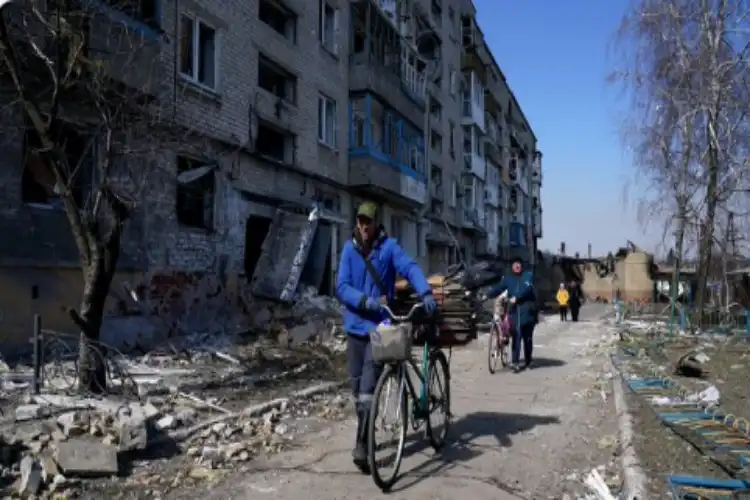
 Sushma Ramachandran
Sushma Ramachandran
The recent assertion by the governor of the Reserve Bank of India, Shaktikanta Das, that the impact of the Ukraine war will be marginal on the economy has come as timely reassurance that the fragile recovery process will not face disruption. He also put fears to rest over the current accommodative policy of the central bank being discontinued and maintained that the central bank would continue to ensure adequate liquidity to support the economy. This is despite headwinds being faced in the form of inflationary pressures owing to soaring world oil prices. His comments come even as several rating agencies like Moody’s and Fitch have downgraded India’s growth projections for the next fiscal. In the case of Moody’s, it has been lowered from 9.5 to 9.1 percent as Fitch ratings have reduced it from 10.2 to 8.5 percent.
The RBI governor may be confident that economic growth will not slow down significantly, but there is no doubt the Ukraine conflict will have some repercussions on the economy. It is also now evident that these will not be as grave as originally expected when the war broke out and western countries imposed a host of sanctions on Russia. The immediate worry has been over the rise in global oil prices, given the fact that India needs to import about 85 percent of its fossil fuel requirements. Concerns were initially twofold, first about the high cost of oil pushing up the import bill to exorbitant levels and second, about the possibility that supplies may be curtailed from oilfields abroad in which investments have been made by this country.
On cost issues, the scenario has improved considerably. Oil prices have not risen as high as analysts had predicted in the initial days of the conflict. World oil markets remain choppy but prices are now hovering in the range of about 100 to 115 dollars per barrel as compared to earlier peaks of over 130 dollars per barrel. Besides, there is an expectation that these stratospheric rates may only be in the short run as prices are likely to soften in the coming months. Thus, there is a realistic expectation that soaring prices will not continue through the next fiscal, and the burden on the exchequer will be bearable. The other positive aspect is that the country has adequate foreign exchange reserves – as much as 677 billion dollars - to meet the compulsions of a short-term spike in oil prices.
The second issue, of supplies from oilfields abroad in which Indian oil companies have made investments, also seems to have been resolved as there has been no alteration so far in production levels. Yet it has been found that output from such oilfields has already dipped from a peak of nearly 25 million tonnes in 2018-19 to about 22 million tonnes in 2020-21 largely owing to reduced commitments made to the oil cartel, OPEC plus. These quantities have been made available from oilfields based in the UAE, South Sudan, Azerbaijan, and Russia.
In the case of Russia, which is facing sanctions, the short-term supply issues have become more complex. Coincidentally, the entire relationship with Russia in the oil sector was expanded just last year in September. Fresh agreements were concluded by IOC and ONGC at that time with the state-owned Gazprom during the visit of Petroleum Minister Hardeep Puri. This was in addition to the existing 16 billion dollars investments made by India in oil and gas assets in the Far East and Siberia. Analysts had even argued at the time that India needs to reduce its dependence on West Asian oil by bringing more oil from Russia through the shorter east Asia sea route.
The latest information about India buying Russian oil at discounted rates needs to be seen in the context of the fact that the purchase is of an extremely small quantity. It comprises less than one percent of the country’s annual crude oil needs. Unlike European countries like Germany which rely on German oil and gas for over 50 percent of their energy requirements, India sources most of its oil supplies from West Asian countries.
Apart from oil, the other areas where there could be an economic impact are fertilizers along with critical metals like nickel and palladium. India imports large quantities of raw materials, intermediates, and finished fertilizers from Russia, and any shortfalls in supply could hit agricultural output. Similarly, prices of nickel and palladium of which Russia is a major supplier, have already shot up and shortages could affect a wide range of industries here. Constraints in coking coal supplies from Russia have also hit steel producers who may have to hike prices.
These increases in tandem with a rise in fuel rates could create further inflationary pressures on the economy. The RBI governor, however, does not anticipate any significant rise in inflation beyond the tolerance range of four to six percent fixed by the central bank. He is equally confident that the 8.9 percent growth projected for the next fiscal will not be affected by the developments in Ukraine.
Despite these reassurances, however, supply-side issues are inevitable in the coming months. These will include commodities coming from Russia and also related to the higher container, freight, and insurance costs.
Also Read: Will the new-look Modi cabinet revive growth?
The main threat right now is thus growing inflation. Though the central bank has expressed confidence that the situation will be contained, the common man is already feeling the pinch with the latest hike in fuel prices. In the coming days, there may also be some marginal price increases of manufactured goods owing to higher imported metal costs. The policy options before the government are limited for the time being as much will depend on the time frame of the conflict in distant Europe. Fortunately, however, the inflationary pressures are likely to be short-term phenomena and the economy looks set to weather this crisis in the medium and long term without any major setbacks.
